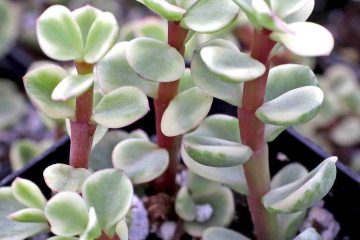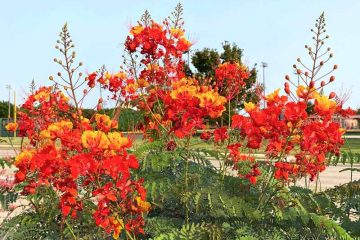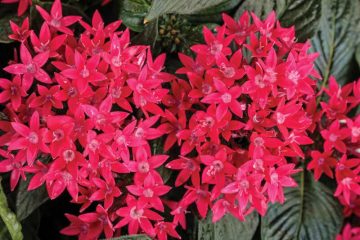The Hibiscus Braided Tree is a stunning ornamental plant, recognized for its unique braided trunk and vibrant blooms. This tree is a hybrid hibiscus with a twisted trunk that creates a visually striking appearance, making it a popular choice for adding elegance to gardens and indoor spaces. Featuring large, showy flowers in various colors, it thrives in warm climates and can be grown in containers or directly in the ground. Proper care involves understanding its light, water, and soil needs to ensure it flourishes. Propagation is typically done through cuttings, allowing gardeners to expand their collection or share the beauty.
| Category | Details |
|---|
| Scientific Name | Hibiscus rosa-sinensis |
| Common Names | Hibiscus Braided Tree, Braided Hibiscus |
| Description | A hybrid hibiscus with a braided trunk and vibrant, large blooms in various colors. |
| Size | Can grow up to 3-5 feet tall, with a similar spread depending on the pot or space. |
| Growth Habit | Compact tree with a braided trunk; blooms are showy and typically single or double-layered. |
| Light Requirements | Prefers bright, indirect light; can tolerate full sun but may need protection from intense midday rays. |
| Watering Needs | Keep soil consistently moist but not soggy; water when the top inch of soil feels dry. |
| Soil Type | Well-draining soil; a mix of potting soil, perlite, and compost works well. |
| Temperature Range | Thrives in temperatures between 60-85°F (15-29°C); protect from frost and extreme cold. |
| Fertilization | Feed with a balanced, water-soluble fertilizer every 4-6 weeks during the growing season (spring and summer). |
| Pruning | Prune after flowering to maintain shape and encourage bushier growth; remove dead or diseased wood. |
| Propagation | Propagate through cuttings taken from healthy plants; use a rooting hormone and keep cuttings in a warm, humid environment until roots develop. |
| Pests and Diseases | Watch for aphids, spider mites, and whiteflies; also prone to fungal issues if overwatered. |
| Repotting | Repot every 1-2 years or when the plant outgrows its pot; choose a pot slightly larger than the current one. |
| Uses | Ideal for container gardening, indoor decoration, and as an ornamental garden plant. |
How To Grow Hibiscus Braided Tree?
The Hibiscus Braided Tree, a unique variety of hibiscus, is known for its braided trunk and vibrant blooms. This plant is a hybrid created by braiding multiple hibiscus stems together. It typically features large, showy flowers in various colors, including red, pink, and white. Ideal for tropical and subtropical climates, the Hibiscus Braided Tree can also thrive in containers indoors. Understanding its needs and characteristics is crucial for successful cultivation.
Choosing the Right Location
The location where you plant your Hibiscus Braided Tree greatly impacts its health and growth. This plant thrives in full sunlight, requiring at least 6 to 8 hours of direct sun exposure daily to encourage robust blooming and strong growth. For outdoor planting, select a spot that is sheltered from strong winds and extreme weather conditions. In cooler climates or indoors, ensure it is placed in a sunny spot near a south-facing window to mimic its natural habitat. Hibiscus Braided Trees are best to decorate in landscapes just like Pentas Plants.
Preparing the Soil
Soil preparation is crucial for the successful growth of your Hibiscus Braided Tree. Hibiscus plants prefer well-draining soil that is rich in organic matter. To achieve this, mix compost, aged manure, or other organic materials into the soil to enhance fertility and drainage. The ideal soil pH for hibiscus ranges from 6.0 to 6.8. For container planting, use a high-quality potting mix that includes perlite or vermiculite to improve drainage and aeration.
Planting the Hibiscus Braided Tree
When planting a Hibiscus Braided Tree, timing and technique are essential. Plant in the spring after the last frost or in early summer to give the tree ample time to establish before winter. Dig a hole that is twice as wide and the same depth as the root ball. Place the tree in the hole, ensuring that the top of the root ball is level with the surrounding soil. Fill the hole with soil, firming it gently around the root ball, and water thoroughly. For container planting, choose a pot that is at least 2-3 inches larger in diameter than the root ball to accommodate future growth.
Watering and Fertilizing
Consistent watering is vital for the Hibiscus Braided Tree. Water deeply when the top inch of soil feels dry, allowing the water to reach the root zone. Avoid letting the plant sit in standing water, as this can lead to root rot. During the growing season (spring and summer), feed the plant every 4-6 weeks with a balanced, water-soluble fertilizer to promote healthy growth and blooming. In the fall and winter, reduce fertilization and allow the plant to enter a semi-dormant state.
Pruning and Maintenance
Pruning is essential for maintaining the shape and health of your Hibiscus Braided Tree. Although Hibiscus Braided Tree is a low maintenance plant like Fairy Castle Cactus. Regular pruning encourages a bushier growth habit and prevents the plant from becoming leggy. Trim back any dead, damaged, or diseased branches to improve air circulation and prevent disease spread. Pinch back the tips of new growth to encourage a fuller, more compact shape. Additionally, remove spent flowers to promote continuous blooming throughout the growing season.
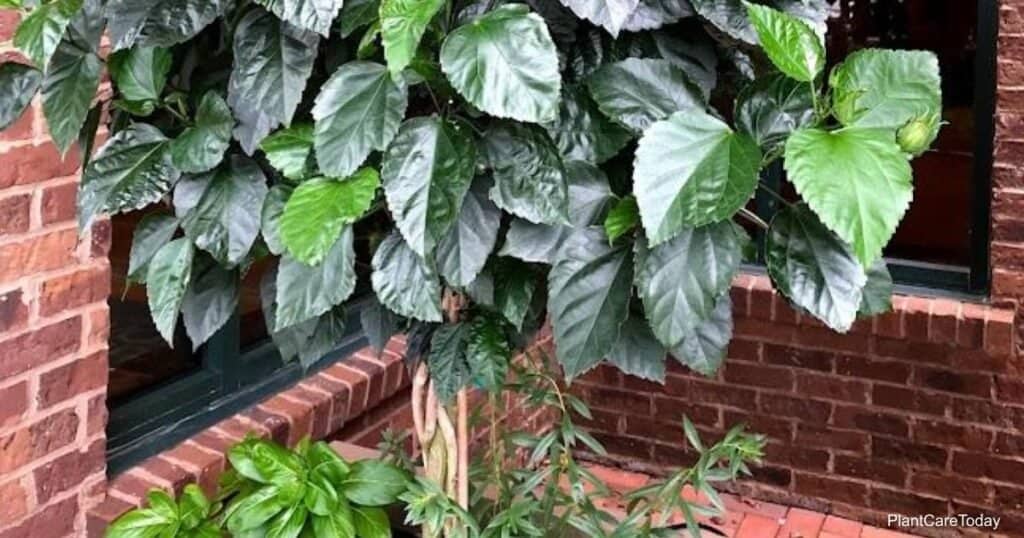
Protecting from Pests and Diseases
Pests and diseases can impact the health of your Hibiscus Braided Tree. Common pests include aphids, spider mites, and whiteflies, which can be managed with insecticidal soap or neem oil. To prevent diseases, maintain proper spacing for airflow and avoid overhead watering to reduce the risk of fungal infections. Regularly inspect the plant for any signs of stress or disease and address issues promptly to ensure the tree remains healthy.
Winter Care for Indoor and Outdoor Plants
Winter care varies depending on whether your Hibiscus Braided Tree is indoors or outdoors. Indoor trees should be kept in a warm environment with consistent light. Reduce watering frequency and ensure the plant is not exposed to drafts or cold temperatures. Outdoor trees in colder climates should be protected from frost by moving them to a sheltered location or covering them with frost cloths. If possible, consider transplanting the tree to a large pot and bringing it indoors for the winter months.

Re-potting and Transplanting
Re-potting is necessary when your Hibiscus Braided Tree becomes root-bound or outgrows its container. Choose a pot that is 2-3 inches larger in diameter than the current one. Gently remove the tree from its old pot, loosen any circling roots, and place it in the new pot with fresh potting mix. Water thoroughly and monitor the plant for signs of transplant shock, such as wilting or yellowing leaves. Transplanting outdoors should be done in the spring or early summer to allow the plant time to acclimate before winter.
Optimal Temperature Conditions
Hibiscus Braided Trees thrive in warm temperatures. Ideal daytime temperatures range from 65°F to 85°F (18°C to 29°C). During the night, temperatures should not drop below 50°F (10°C). Protect the tree from temperature extremes, as cold drafts or sudden temperature changes can stress the plant. For indoor plants, consider using a small space heater or grow lights if your home gets too cold in winter.
Humidity Requirements
Hibiscus plants prefer high humidity levels, particularly when grown indoors. If your home is dry, especially during winter, increase humidity by placing a humidifier near the plant or by setting the pot on a tray filled with water and pebbles. Regular misting of the foliage can also help maintain adequate humidity. However, avoid excessive misting, as it can lead to fungal issues.
Enhancing Bloom Production
To encourage abundant blooming, ensure your Hibiscus Braided Tree receives adequate nutrients. Use a fertilizer high in phosphorus (the middle number in the N-P-K ratio) to promote flower production. Additionally, provide consistent watering and avoid letting the soil dry out completely, as this can stress the plant and reduce blooming. Regular deadheading of spent flowers also encourages more blooms by redirecting energy from seed production to new flower formation.
Using Mulch for Soil Health
Applying mulch around the base of your Hibiscus Braided Tree can help retain soil moisture, regulate temperature, and suppress weeds. Use organic mulch such as shredded bark, wood chips, or straw. Apply a layer about 2 to 3 inches thick, keeping it a few inches away from the trunk to prevent rot. Replenish the mulch as needed to maintain its effectiveness.
Fertilizer Types and Application
While a balanced, water-soluble fertilizer is ideal for general growth, consider using slow-release fertilizers for more sustained nutrient availability. Granular fertilizers applied once every 6 to 8 weeks can provide long-term nourishment. Liquid fertilizers can be applied more frequently, every 4 weeks, during the growing season for quicker nutrient uptake.
Root Pruning Techniques
Root pruning can be beneficial for maintaining the health of your Hibiscus Braided Tree, especially if it becomes root-bound. When re-potting, gently trim back any excessively long or circling roots. This encourages new root growth and prevents the plant from becoming pot-bound. Root pruning can also help in controlling the size of the plant and promoting a more robust root system.
Companion Planting
Companion planting can enhance the health and aesthetics of your Hibiscus Braided Tree. Planting complementary species, such as marigolds or nasturtiums, can help deter pests and attract beneficial insects like pollinators. Additionally, grouping your hibiscus with other tropical plants that have similar care requirements can create a cohesive and visually appealing garden design.
Seasonal Care Adjustments
Adjust your care routine according to the seasons. In spring and summer, focus on promoting vigorous growth and blooming by increasing watering and fertilizing. In fall, gradually reduce feeding and allow the plant to prepare for dormancy. In winter, minimize watering and ensure the plant receives adequate light and warmth to prevent stress.
Handling Transplant Shock
Transplant shock can occur when moving your Hibiscus Braided Tree to a new location. To minimize shock, prepare the new site in advance and water the plant thoroughly before the move. After transplanting, keep the plant in a shaded area for a few days to reduce stress. Monitor for signs of stress, such as wilting or yellowing leaves, and adjust care accordingly.
Training and Shaping
Training your Hibiscus Braided Tree to maintain its braided trunk and desired shape requires regular attention. As the plant grows, gently adjust and guide the branches to maintain the braid. Prune selectively to ensure an even distribution of branches and to remove any unwanted growth. This will help preserve the tree’s aesthetic appeal and overall health.
Pest and Disease Management
Implement preventative measures to protect your Hibiscus Braided Tree from pests and diseases. Regularly inspect the plant for early signs of issues and use organic pest control methods when necessary. For fungal diseases, ensure good air circulation around the plant and avoid overhead watering. Applying a neem oil solution or insecticidal soap can effectively manage common pest problems.
How To Care for Hibiscus Braided Tree?
Caring for a Hibiscus Braided Tree involves a few specific steps to ensure it thrives. Here’s a guide to help you:
- Light: Hibiscus trees prefer bright, indirect light. Place them near a window where they can receive ample sunlight but avoid direct, harsh sun which can scorch the leaves.
- Watering: Keep the soil consistently moist but not waterlogged. Water when the top inch of soil feels dry. During the growing season (spring and summer), you may need to water more frequently. In winter, reduce watering slightly.
- Humidity: Hibiscus trees thrive in higher humidity. If you live in a dry climate, consider using a humidity tray or a room humidifier to maintain moisture levels around the plant.
- Temperature: They prefer warm temperatures, ideally between 60°F and 70°F (15°C to 21°C). Protect the plant from cold drafts and sudden temperature changes.
- Soil: Use well-draining potting soil. A mix designed for tropical plants or a blend of peat, perlite, and pine bark works well.
- Fertilizing: Feed the plant with a balanced, water-soluble fertilizer every 4-6 weeks during the growing season (spring and summer). Reduce feeding in the winter.
- Pruning: Regularly trim the plant to maintain its shape and promote new growth. Prune after flowering to keep it tidy and encourage branching.
- Repotting: Repot the tree every 1-2 years or when it outgrows its current container. Choose a pot that is 1-2 inches larger in diameter than the current one.
- Pests and Diseases: Watch for common pests like aphids, spider mites, and whiteflies. Treat infestations with insecticidal soap or neem oil. Ensure good air circulation around the plant to prevent fungal issues.
- Winter Care: If you live in a region with cold winters, consider moving the plant indoors during the colder months. Ensure it still gets enough light and maintains appropriate temperature and humidity.
Additional Care Tips
- Repotting Timing: When repotting, do it in the spring before the growing season starts. This helps the plant settle in before it begins its active growth phase.
- Pruning Techniques: Use clean, sharp pruning shears to avoid damaging the plant. Remove any dead or yellowing leaves and spent flowers. For shaping, prune back just above a leaf node to encourage new growth.
- Pest Management: Inspect your plant regularly for signs of pests. If you notice pests, isolate the plant from others to prevent spread. For persistent issues, consider systemic insecticides or consult with a local gardening expert.
- Water Quality: Use distilled or rainwater if possible, as tap water can contain chemicals like chlorine and fluoride that may be harmful to your plant over time. If using tap water, let it sit for 24 hours to allow chlorine to dissipate.
- Soil pH: Hibiscus plants prefer slightly acidic to neutral soil (pH 6.0-7.0). You can test the soil pH with a home testing kit and adjust if necessary using soil amendments.
- Flower Care: If your plant is not flowering as expected, check that it’s receiving enough light, nutrients, and water. Sometimes, a lack of flowering can also indicate a need for pruning or repotting.
- Training and Support: As the tree grows, you may need to provide support or stakes to help maintain its shape and prevent the braided trunk from becoming too top-heavy.
- Seasonal Adjustments: In regions with distinct seasons, consider adjusting your care routine based on the weather. For example, during the hotter months, you might need to water more frequently or provide shade during the hottest part of the day.
- Fertilizer Types: Opt for a balanced fertilizer with equal parts nitrogen, phosphorus, and potassium (e.g., 10-10-10) or a formula specifically designed for flowering plants. Avoid over-fertilizing, as this can lead to excessive leaf growth at the expense of flowers.
- Leaf Drop: If you notice leaves dropping, it could be due to sudden changes in the environment, such as drafts, or issues like overwatering or underwatering. Try to maintain a consistent environment and adjust your care as needed.
How to Propagate Hibiscus Braided Tree?
The Hibiscus Braided Tree, known for its striking braided trunk and vibrant blossoms, can be an eye-catching addition to your garden. Propagation allows you to grow new plants from an existing one, ensuring the beauty and variety of your Hibiscus collection. This guide will walk you through the steps required to propagate a Hibiscus Braided Tree successfully, covering various methods and tips to ensure the process is effective. Whether you want to expand your garden or share this beautiful plant with friends, proper propagation techniques are essential for thriving new plants.
Choosing the Right Time for Propagation
Timing is crucial for successful propagation of Hibiscus Braided Trees. The best time to propagate is during the growing season, typically in spring or early summer when the plant is actively growing. During this period, the tree is more likely to root successfully and establish itself. Avoid propagating in winter or late fall, as the plant’s growth slows down and rooting can be less successful. Additionally, ensure that your parent plant is healthy and free from diseases, as a robust plant will produce stronger cuttings.
Selecting and Preparing Cuttings
To start the propagation process, you need to take cuttings from a healthy Hibiscus Braided Tree. Choose semi-hardwood cuttings, which are semi-ripe but not too old or too young. Ideally, the cuttings should be about 4 to 6 inches long and have several leaves. Use a sharp, clean knife or pruners to make a clean cut just below a leaf node. Remove the lower leaves from the cutting, leaving only a couple of leaves at the top. This helps reduce water loss and encourages root development.
Rooting Hormone Application
Applying rooting hormone can significantly increase the chances of successful rooting. Dip the cut end of each cutting into a rooting hormone powder or gel, following the manufacturer’s instructions. This hormone stimulates root growth and helps the cutting establish itself more quickly. Make sure to tap off any excess hormone before planting to prevent fungal issues. While rooting hormone isn’t always necessary, it can improve the rooting process and lead to healthier new plants.
Planting Cuttings
Prepare a pot with a well-draining potting mix, such as a combination of peat moss, perlite, and sand. Fill the pot with the mix and make a hole in the center with a pencil or stick. Insert the cutting into the hole, making sure it’s buried about halfway up the stem. Gently press the soil around the cutting to hold it in place. Water the soil lightly to ensure it is moist but not waterlogged. Proper drainage is essential to prevent root rot and other issues.
Creating a Humid Environment
Maintaining a humid environment around the cuttings can enhance rooting success. Cover the pot with a clear plastic bag or a plastic dome to create a mini-greenhouse effect. This helps retain moisture and creates a warm, humid environment that promotes root development. Place the pot in a bright, indirect light location but avoid direct sunlight, which can overheat the cuttings and reduce rooting success. Check the cuttings regularly to ensure they are not too dry or too wet.
Transplanting the New Plants
Once the cuttings have developed a healthy root system, usually after 4 to 6 weeks, they can be transplanted into larger pots or directly into the garden. Gently remove the cuttings from their original pots, being careful not to damage the new roots. Prepare the new planting area by loosening the soil and adding organic matter if needed. Plant the rooted cuttings at the same depth they were in their pots, and water thoroughly to help them acclimate to their new environment.
Caring for Newly Transplanted Trees
After transplanting, provide proper care to help your new Hibiscus Braided Trees thrive. Ensure they receive adequate water, keeping the soil consistently moist but not soggy. Fertilize with a balanced, water-soluble fertilizer every 4 to 6 weeks during the growing season to encourage healthy growth and blooming. Monitor the plants for pests and diseases, addressing any issues promptly. As the trees establish themselves, they may require less frequent watering and fertilization. Regular pruning can help maintain their shape and encourage vigorous growth.
Troubleshooting Common Issues
Propagation of Hibiscus Braided Trees may come with challenges. If the cuttings fail to root, check for potential issues such as inadequate humidity, incorrect soil moisture, or poor light conditions. Yellowing leaves or mold on cuttings may indicate overwatering or poor air circulation. Adjust the care conditions as needed to address these problems. If transplant shock occurs, provide extra care and protection to help the plants recover. With attention and proper care, your propagated Hibiscus Braided Trees should flourish and bring beauty to your garden.
Common Pests and Diseases of Hibiscus Braided Tree
The Hibiscus Braided Tree, also known as the Braided Hibiscus, is a popular ornamental plant that can sometimes be affected by pests and diseases. Here are some common issues:
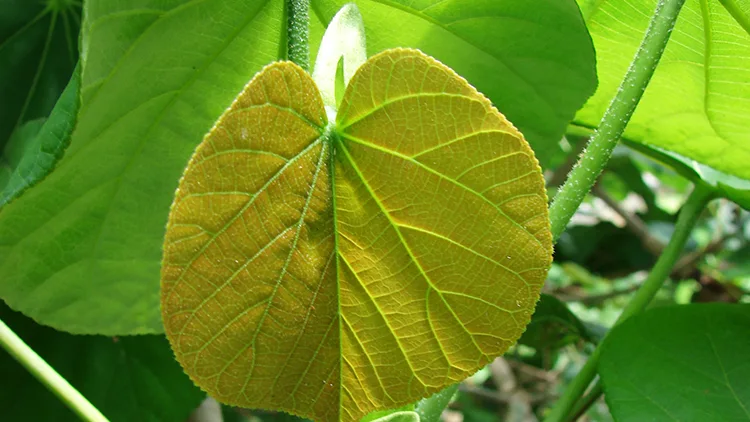
Pests:
- Aphids:
- Symptoms: Sticky residue on leaves, distorted growth.
- Control: Insecticidal soap, neem oil, or natural predators like ladybugs.
- Spider Mites:
- Symptoms: Fine webbing on leaves, stippled or discolored foliage.
- Control: Increase humidity, use miticides, or rinse the plant with water.
- Whiteflies:
- Symptoms: White, flying insects, sticky residue, yellowing leaves.
- Control: Yellow sticky traps, insecticidal soap, or neem oil.
- Mealybugs:
- Symptoms: Cotton-like white masses, stunted growth, sticky residue.
- Control: Remove mealybugs by hand, use insecticidal soap, or neem oil.
- Scale Insects:
- Symptoms: Hard, waxy bumps on leaves and stems.
- Control: Scrape off manually, use horticultural oil, or insecticidal soap.
Diseases:
- Leaf Spot:
- Symptoms: Brown or black spots on leaves, often with a yellow halo.
- Control: Improve air circulation, avoid overhead watering, and remove affected leaves.
- Powdery Mildew:
- Symptoms: White, powdery substance on leaves and stems.
- Control: Increase air circulation, avoid overhead watering, and apply fungicides if needed.
- Root Rot:
- Symptoms: Wilting, yellowing leaves, and mushy roots.
- Control: Ensure proper drainage, avoid overwatering, and remove affected roots.
- Bacterial Leaf Blight:
- Symptoms: Water-soaked spots that turn brown, leading to leaf drop.
- Control: Remove infected leaves, improve air circulation, and avoid wetting foliage.
Prevention Tips:
- Regular Inspection: Check your plant frequently for signs of pests or disease.
- Proper Watering: Avoid overwatering and ensure good drainage.
- Healthy Soil: Use well-draining soil and consider adding compost to boost plant health.
- Pruning: Regularly prune dead or infected parts of the plant to prevent the spread of issues.
By keeping an eye on your Hibiscus Braided Tree and providing proper care, you can help prevent and manage these common problems.


